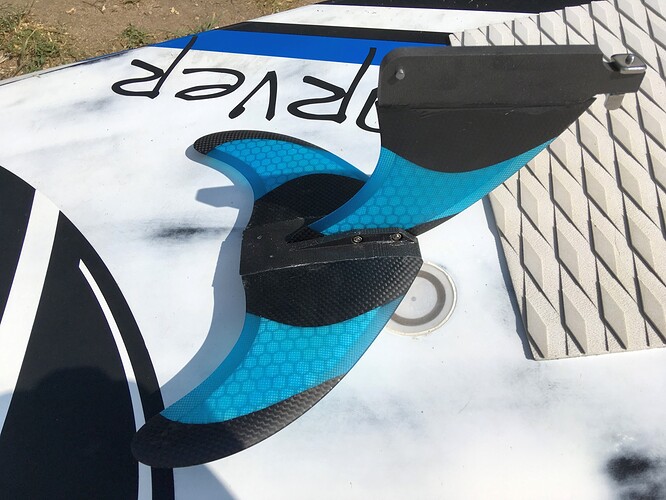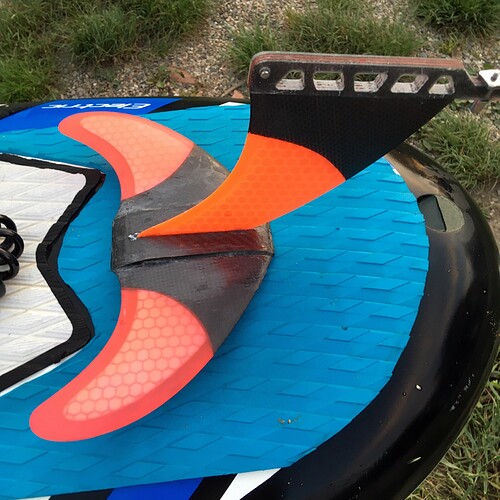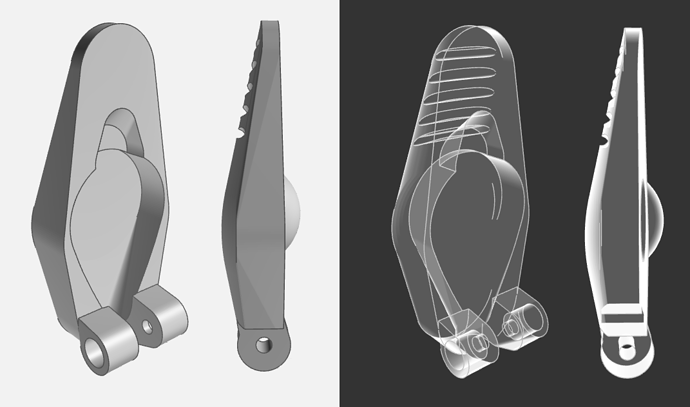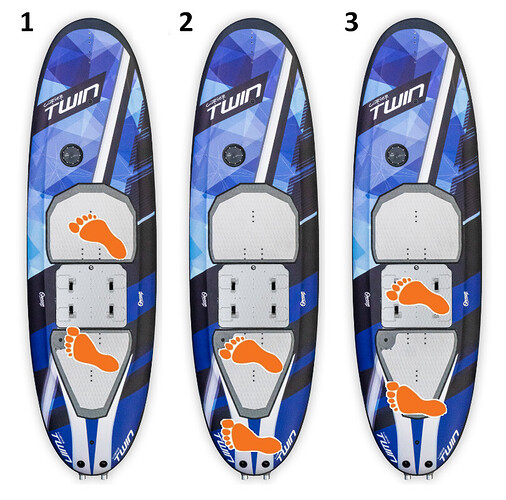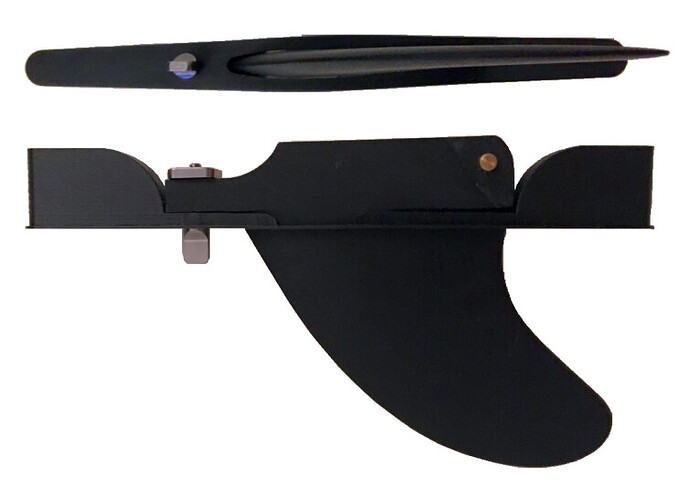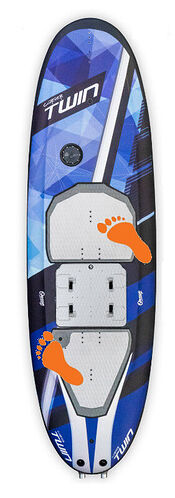G7 type I model
In the article Carver fins with wings DIY Part I I offered a basic solution that I used last season. The good news is that this solution will get riders weighing up to 95 kg (even with the use of a newly reinforced and therefore heavier (14 kg) battery), although sometimes with problems, with 93 kg always without problems. I weighed more than I thought, because my weight showed a bad value (the difference was about 2 kg). During the season, my weight decreased due to the movement and thus the riding speed increased.
Figure 1 - My best type I model
The bad news is that the fin holders cracked quite often, even though they were made of fiberglass-reinforced nylon 12.
G7 type II model
For the new season, I therefore designed a new model of a stronger holder, again with an angle of attack of 6 °, which does not require any modification of the fins except drilling holes and which also has reduced resistance due to the absence of screws and protrusions for their placement. I replaced the screws with steel rods with a diameter of 3 mm made of stainless steel. I used the other two rods to reinforce the most stressed part of the holder. I also learned to vacuum coat the brackets with carbon fiber cloth to reduce resistance and a nicer appearance, although I still have quite a lot of reserves in polishing the carbon surface.
Here is the overall result of my efforts in red.
Figure 2 - finished new G7 type II model
Even so, the first test of this new model would be very successful in the first run of the 2020 season, and even with a weight of 97.5 kg (due to coronavirus quarantine), I easily achieved a planning and a maximum speed of 29.9 km / h. The total starting weight was therefore about 130 kg (98 + 18 + 14).
Figure 3 - G7 side fins holder - glued model
The G7 Holder model can be downloaded here.
Finbox adapter
New model of Finbox adapter with fixing screws, for which it is necessary to cut out the internal thread M3. Holes approx. 2 mm deep must be drilled into the shafts of the central fins through the screw holes to insert the tip of the fixing screw. The fins will be secured mechanically not only by friction.
The Finbox Adapter model can be downloaded here.
However, I used longbord fins 6" for assembly, which do not require a Finbox adapter.
Figure 4 - FCS to Longboard Fin box adapter - model
Trigger
I also offer a new, more robust version of the trigger. The old model cracked several times. This one will definitely not crack anymore.
Figure 5 Trigger - model
The Trigger model can be downloaded here.
Carver versus Carver Twin
Due to technical problems with my worn out Carver (440 batteries had already been driven), I was forced to switch to the Carver Twin model in the middle of the season. I tested my latest model of winged fins on both models and can therefore compare the two surfboards.
Carver
The Carver with a single nozzle rider weighing 95 kg will easily get into the planning with the model II in no wind in about 30 seconds and reaches a maximum speed of 30 km/h in about 60 seconds. In this configuration, the Carver is quite sensitive to headwinds and the speed easily falls below the planning limit (approx. 18-20 km/h) when driving against the wind for a long time.
Carver Twin
With a model II, the Carver Twin with two nozzles weighing 95 kg will get into planning in 10 seconds and reach a maximum speed of 32 km/h in about 30 seconds. When riding against the wind, it decelerates by only about 1 to 2 km/h.
Riding technique
Winged fins quite reduce the rotation of the surfboard and to improve it it is necessary to adjust the position of the rider on the surfboard and riding technique. For both surfboards, therefore, I glued the back part with a self-adhesive foam foil so that it could stand safely on it.
Figure 6 Foam in the back
The most important thing is to keep the center of gravity correct, which must be readily changed while riding according to the current situation. This avoids, for example, slowing down when riding against the wind or, conversely, helps to increase the acceleration of the surfboard.
Figure 7 Used positions of center of gravity on Carver Twin
1 - basic position - the legs are in the footstraps position (it’s quite a problem to get into planning)
2 - center of gravity shifted maximally back (for speed riding almost without turning)
3 - center of gravity shifted back (for normal slalom turning)
According to my knowledge, winged fins model type II and Carver Twin will also get rider weighing well over 100 kg into the planning (I estimate a maximum of 110 kg - but not tested). I could not get over 33km/h with the rider’s weight of 95 kg.
Therefore, I started experimenting with ordinary smaller 5 "fins and soon I reached a maximum speed of 37.2 km/h, an average speed of 30 km/h, one battery riding distance 8.47 km (riding time 15-16 minutes). Without winged fins, it takes about 60 seconds to start the Carver Twin at full speed, and to achieve a planning, the center of gravity must be moved much forward.
My intention is to reach a speed of 40 km/h next season with 3 "fins equipped with a cover on the slot.
Figure 8 - 3" fin with cover
I am adding 3 more links to download the Charging Connector model for the new battery here, Remote Controller Cover here and for the Safety Magnet Frame here.
